
The US Route 20 Viaduct in Conneaut Ohio, a new structure built in 2004 to replace the city’s crumbling historic viaduct, will soon be dedicated to Ohio military veterans. You can find some pictures of the new and the old US 20 Viaduct here. This is actually the third viaduct built in this area, which carries US 20 over Conneaut Creek and active railroad tracks. At the time the second viaduct was built, a plaque on the old bridge lists US 20 as “Chicago-Buffalo Road.”
US 20 is currently named Main Street and Harbor Street as it goes through Conneaut.
Here is the story on the dedication from The Star Beacon:
Bridge renamed for veterans
By MARK TODD - Staff Writer Star Beacon
CONNEAUT — Early next year, the Route 20 viaduct in Conneaut will stand as a tribute to Ohio’s military veterans.
US 20 is currently named Main Street and Harbor Street as it goes through Conneaut.
Here is the story on the dedication from The Star Beacon:
Bridge renamed for veterans
By MARK TODD - Staff Writer Star Beacon
CONNEAUT — Early next year, the Route 20 viaduct in Conneaut will stand as a tribute to Ohio’s military veterans.
Earlier this week, members of the Ohio House of Representatives approved a bill that formally names the bridge “The Ohio Veterans Memorial Bridge.” The designation will take effect once the bill is signed by Gov. Ted Strickland, action expected within the next few weeks.
The recognition culminates months of work by two city veterans, Tom Shugerts and Paul Nelson. The pair approached then-state Rep. George Distel with the idea in 2007, he said. In September of that year, a bill sponsored by Distel was introduced into the House.
The Ohio Department of Transportation will prepare signs that will be erected at either end of the bridge, Nelson said. The signs could be unveiled during a special ceremony to be held around Memorial Day 2009, he said.
“We’ve started the planning,” said Nelson, adjutant sergeant-at-arms at American Legion Cowle Post 151 in Conneaut.
Nelson and Shugerts would also like to erect a monument to veterans at the end of the span. “It would be a nice tribute,” Nelson said.
Shugerts and Nelson have already unofficially adopted the bridge, erecting American flags and Armed Forces banners on lampposts that dot the span. The flags are installed shortly before Memorial Day and removed after Veterans Day, he said.
In a statement, State Rep. Deborah Newcomb, D-Conneaut, said the designation “is a proper and honorable way to commemorate Ohio’ servicemen and women.”
The US Route 20 Blog homepage can be found here.
The recognition culminates months of work by two city veterans, Tom Shugerts and Paul Nelson. The pair approached then-state Rep. George Distel with the idea in 2007, he said. In September of that year, a bill sponsored by Distel was introduced into the House.
The Ohio Department of Transportation will prepare signs that will be erected at either end of the bridge, Nelson said. The signs could be unveiled during a special ceremony to be held around Memorial Day 2009, he said.
“We’ve started the planning,” said Nelson, adjutant sergeant-at-arms at American Legion Cowle Post 151 in Conneaut.
Nelson and Shugerts would also like to erect a monument to veterans at the end of the span. “It would be a nice tribute,” Nelson said.
Shugerts and Nelson have already unofficially adopted the bridge, erecting American flags and Armed Forces banners on lampposts that dot the span. The flags are installed shortly before Memorial Day and removed after Veterans Day, he said.
In a statement, State Rep. Deborah Newcomb, D-Conneaut, said the designation “is a proper and honorable way to commemorate Ohio’ servicemen and women.”
The US Route 20 Blog homepage can be found here.












 Last July, I wrote here about the
Last July, I wrote here about the 







